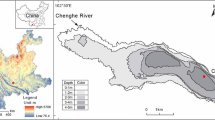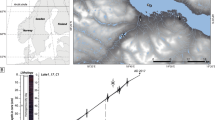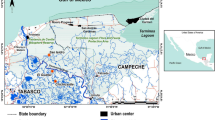Abstract
The frequency of nuisance algal blooms has been increasing during the last two decades in the shallow, headwater East Pond (Smithfield, Maine, USA). Meanwhile, the hydrologically linked North Pond has not experienced an increase in algal blooms, despite similar morphometry and higher external nutrient loads. Possible explanations for this difference include stronger trophic cascade effects from planktivorous white perch (Morone americana) in East Pond as well as differences in phosphorus (P) release from the sediments of these two lakes. We conducted a paleolimnological investigation of these two lakes to assess whether sedimentary evidence supported trophic cascade effects based on cladoceran ephippia size, diatom fossils, and fossil pigments or biogeochemical controls based on potential sedimentary P release as the primary driver of these increased algal blooms in East Pond. At the time of white perch introduction (~1930–1950), ephippia size increases in East Pond, although no changes are observed in either diatom abundance or trends in the algal pigments. Instead, algal pigments increase in recent decades (~1980 to present) along with an increase in diatom taxa with higher TP optima These results suggest that predation by white perch is not resulting in top-down effects on algal abundance in East Pond, as predicted by the trophic cascade hypothesis. While the P content of sediments from both lakes is relatively equal, the releasable P in the top 10 cm of sediment in East Pond constitutes a greater percentage of the P extracted. Also, North Pond sediments exhibit a greater capacity to permanently bury P via the mechanisms of sorption to Al(OH)3(s) and a slower mineralization of organic P compounds. The results of this investigation suggest that the ultimate driver of the recent algal blooms in East Pond is internal P release from the sediments instead of trophic cascade effects.








Similar content being viewed by others
References
Ahlgren J, Tranvik L, Gogoll A, Waldebäck M, Markides K, Rydin E (2005) Sediment depth attenuation of biogenic phosphorus compounds measured by 31P NMR. Environ Sci Technol 39:867–872
Ahlgren J, De Brabandere H, Reitzel K, Rydin E, Gogoll A, Waldebäck M (2007) Sediment phosphorus extractants for phosphorus-31 nuclear magnetic resonance analysis: a quantitative evaluation. J Environ Qual 36:892–898
Birks HJB (1995) Quantitative paleoenvironmental reconstructions. In: Maddy D, Brew JS (eds) Statistical modeling of quaternary science data. Cambridge University Press, Cambridge, pp 161–254
Cade-Menum BJ, Navaratnam JA, Walbridge MR (2006) Characterizing dissolved and particulate phosphorus in water with 31P nuclear magnetic resonance spectroscopy. Environ Sci Technol 40:7874–7880
Camburn KE, Charles DF (2000) Diatoms of low-alkalinity lakes in the northeastern United States. Acad Natl Sci Phila Spec Publ. 18
Carpenter SR, Leavitt PR (1991) Temporal variation in a paleolimnological record arising from a trophic cascade. Ecology 72(1):277–285
Carpenter SR, Kitchell JF, Hodgson JR (1985) Cascading trophic interactions and lake productivity. Bioscience 35:634–639
Carpenter SR, Kitchell JF, Hodgson JR, Cochran PA, Elser JJ, Elser MM, Lodge DM, Kretchmer D, He X, von Ende CN (1987) Regulation of lake productivity by food web structure. Ecology 68:1863–1876
Christensen ER (1982) A model for radionuclides in sediments influenced by mixing and compaction. J Geophys Res 87:566–572
Colby College (1997) Land use patterns in relation to lake water quality in the North Pond watershed Waterville, Me: BI 493, Problems in Environmental Science, Colby College
Collins TJ (2007) ImageJ for microscopy. BioTechniques 43:25–30
DeMott WR, Kerfoot WC (1982) Competition among cladocerans: nature of the interaction between Bosmina and Daphnia. Ecology 63:1949–1966
Maine Department of Environmental Protection (2001) East Pond Total Maximum Daily (Annual) Load Final Report, Document# DEPLW2001–10. MDEP, Augusta
Dillon PJ, Rigler FH (1974) A test of a simple nutrient budget model predicting the phosphorus concentration in lake water. J Fish Res Board Can 31:1771–1778
Dixit SS, Smol JP (1994) Diatoms as indicators in the environmental monitoring and assessment program–surface waters (EMAP-SW). Environ Monit Assess 31:275–306
Dodds WK, Bouska WW, Eitzmann JL, Pilger TJ, Pitts KL, Riley AJ, Schloesser JT, Thornburgh DJ (2009) Eutrophication of U.S. freshwaters: analysis of potential economic damages. Environ Sci Technol 43:12–19
Dodson SI, Newman AL, Will-Wolf S, Alexander ML, Woodford MP, Van Egeren S (2009) The relationship between zooplankton community structure and lake characteristics in temperate lakes (Northern Wisconsin USA). J Plankton Res 31:93–100
Eakins JD, Morrison RT (1978) A new procedure for the determination of lead-210 in lake and marine sediments. Int J Appl Radiat Isot 29:531–536
Finlay K, Beisner BE, Patoine A, Pinel-Alloul B (2007) Regional ecosystem variability drives the relative importance of bottom-up and top-down factors for zooplankton size spectra. Can J Fish Aquat Sci 64:516–529
Ginn BK, Cumming BF, Smol JP (2007) Diatom-based environmental inferences and model comparisons from 494 northeastern North American lakes. J Phycol 43:647–661
Halliwell D, Evers M (2008) A maine success story. Lakelines 28:37–43
Hupfer M, Lewandoski J (2005) Retention and early diagenetic transformation of phosphorus in Lake Arendsee (Germany)–consequences for management strategies. Archiv Hydrobiol 164:143–157
Hupfer M, Lewandoski J (2008) Oxygen controls the phosphorus release from lake sediments–a long-lasting paradigm in limnology. Int Revue Hydrobiol 93:415–432
Jeppesen E, Leavitt P, De Meester L, Jensen JP (2001) Functional ecology and paleolimnology: using cladoceran remains to reconstruct anthropogenic impact. Trends Ecol Evol 16:191–198
Jeppesen E, Jensen JP, Amsinck S, Landkildehus F, Lauridsen T, Mitchell SF (2002) Reconstructing the historical changes in Daphnia mean size and planktivorous fish abundance in lakes from the size of Daphnia ephippia in sediment. J Paleolimnol 27:133–143
Jeppesen E, Jensen JP, Lauridsen TL, Amsinck AL, Christoffersen K, Sondergaard M, Mitchell SF (2003) Sub-fossils of cladocerans in the surface sediment of 135 lakes as proxies for community structure of zooplankton, fish abundance and lake temperature. Hydrobiology 491:321–330
Kopáček J, Borovec J, Hejzlar J, Ulrich K, Norton S, Amirbahman A (2005) Aluminum control of phosphorus sorption in lake sediments. Environ Sci Technol 39:8784–8789
Kopáček J, Marešová M, Norton S, Porcal P, Veselý J (2006) Photochemical source of metals for sediments. Environ Sci Technol 40:4455–4459
Lake B (2009) Biogeochemical phosphorus cycling in the sediments of shallow temperate lakes. Doctoral Dissertation, The University of Maine, Orono, ME
Lake B, Coolidge K, Norton S, Amirbahman A (2007) Factors contributing to the internal loading of phosphorus from anoxic sediments in six Maine (USA) lakes. Sci Total Environ 373:534–541
Leavitt PR (1993) A review of factors that regulate carotenoid and chlorophyll deposition and fossil pigment abundance. J Paleolimnol 9:109–127
Leavitt PR, Carpenter S (1989) Whole-lake experiments: the annual record of fossil pigments and zooplankton. Limnol Oceanogr 34(4):700–717
Leavitt PR, Findlay DL (1994) Comparison of fossil pigments with 20 years of phytoplankton data from eutrophic Lake 227, Experimental Lakes Area, Ontario. Can J Fish Aquat Sci 51:2286–2299
Likens GE, Bormann FH (1974) Linkages between terrestrial and aquatic ecosystems. Bioscience 24:447–456
McGowan S (2007) Pigments in sediments of aquatic environments. In: Elias S (ed) Encyclopedia of quaternary sciences. Elsevier, Amsterdam
Mortimer C (1941) The exchange of dissolved substances between mud and water in lakes. J Ecol 29:280–329
Murphy J, Riley JP (1962) A modified single solution method for the determination of phosphate in natural waters. Anal Chim Acta 27:31–36
Nittrouer CA, DeMaster DJ, McKee BA, Cutshall NH, Larsen IL (1984) The effect of sediment mixing on Pb-210 accumulation rates for the Washington continental shelf. Mar Geol 54:201–221
Nurnberg GK (1984) The prediction of internal phosphorus loads in lakes with anoxic hypolimnia. Limnol Oceanogr 29:111–129
Oldfield F, Appleby FG (1984) Empirical testing of 210Pb dating models for lake sediments. In: Haworth EY, Lund JWG (eds) Lake sediments and environmental history. University of Minnesota Press, Minneapolis, pp 93–124
PEARL (2008) The source for environmental information. The University of Maine, Orono, ME http://www.pearl.maine.edu/. Accessed March 23, 2008)
Prairie YT, De Montigny C, Del Giorgio PA (2001) Anaerobic phosphorus release from sediments: a paradigm revised. Verh Internat Verein Theor Angew Limnol 27:4013–4020
Psenner R, Pucsko R, Sager M (1984) Fractionation of organic and inorganic phosphorus compounds in lake sediments. Archiv Hydrobiol 70:111–115
Reitzel K, Hansen J, Andersen FO, Hansen KS, Jensen HS (2005) Lake restoration by dosing aluminum relative to mobile phosphorus in the sediment. Environ Sci Technol 39:4134–4140
Schaeffer JS, Margraf FJ (1986a) Population characteristics of the invading white perch (Morone americana) in Western Lake Erie. J Great Lakes Res 12:127–131
Schaeffer JS, Margraf FJ (1986b) Food of white perch (Morone americana) and potential for competition with yellow perch (Perca flavescens) in Lake Erie. Ohio J Sci 86:26–29
Schindler DW, Hecky RE, Findlay DL, Stainton MP, Parker BR, Paterson MJ, Beaty KG, Lyng M, Kasian SEM (2008) Eutrophication of lakes cannot be controlled by reducing N input: results of a 37-year whole-ecosystem experiment. Proc Natl Acad Sci 105:11254–11258
Søndergaard M, Jensen JP, Jeppesen E (2003) Role of sediment and internal loading of phosphorus in shallow lakes. Hydrobiology 506–509:135–145
Tessenow VU (1974) Solution diffusion and sorption in the upper layer of lake sediments. IV. Reaction mechanisms and equilibria in the system iron-manganese-phosphate with regard to the accumulation of vivianite in Lake Ursee. Archiv Hydrobiol 47:1–79
Trinko T (2007) Bottom-up and top-down controls on algal bloom frequency in two shallow mesotrophic lakes. Unpublished Master’s Thesis, The University of Maine, Orono, ME
Tuominem L, Kairesalo T, Hartikainen H, Tallberg P (1996) Nutrient fluxes and microbial activity in sediment enriched with settled seston. Hydrobiology 335:19–31
Turner B, Mahieu N, Condron L (2003) Phosphorus-31 nuclear magnetic resonance spectral assignments of phosphorus compounds in soil NaOH–EDTA extracts. Soil Sci Soc Am J 67:497–510
Vanni MJ (2002) Nutrient cycling by animals in freshwater ecosystems. Annu Rev Ecol Sys 33:341–370
Wolin JA, Duthie HC (1999) Diatoms as indicators of water level change in freshwater lakes. In: Stoermer EF, Smol JP (eds) The diatoms: applications for the environmental and earth sciences. Cambridge University Press, Cambridge, pp 183–202
Acknowledgments
Funding for this work was provided by grants from the U.S. National Science Foundation (DEB-0415348), and the U.S. Geological Survey-Water Resources Research Institute (2007ME108B). The authors are grateful to David Halliwell at the Maine Department of Environmental Protection and Dr. Whitney King at Colby College for supplying data and advice; Megan Tylka for field assistance, sample preparation, and GIS assistance; Dennis Anderson and Heather Arnett for diatom analysis; Dr. Brian Ginn at Queens University for running the TP inference models; the Colby College Chemistry Department for use of their NMR instrumentation; Suzanne McGowan at the University of Nottingham for providing assistance with pigment analysis; and the Department of Physics at the University of Maine for providing the 210Pb dates. We would also like to thank the insightful comments and improvements of two anonymous reviewers.
Author information
Authors and Affiliations
Corresponding author
Rights and permissions
About this article
Cite this article
Lake, B.A., Wigdahl, C.R., Strock, K.E. et al. Multi-proxy paleolimnological assessment of biogeochemical versus food web controls on the trophic states of two shallow, mesotrophic lakes. J Paleolimnol 46, 45–57 (2011). https://doi.org/10.1007/s10933-011-9513-1
Received:
Accepted:
Published:
Issue Date:
DOI: https://doi.org/10.1007/s10933-011-9513-1




